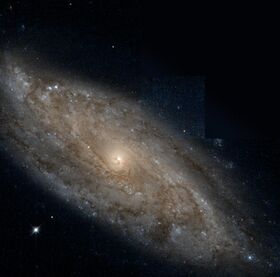Astronomy:NGC 7314
| NGC 7314 | |
|---|---|
 NGC 7314 taken from Hubble Space Telescope | |
| Observation data (J2000 epoch) | |
| Constellation | Piscis Austrinus |
| Right ascension | 22h 35m 46.19699s[1] |
| Declination | −26° 03′ 01.5740″[1] |
| Redshift | 0.004743±0.000020[2] |
| Helio radial velocity | 1,427 km/s[3] |
| Distance | 54.6 Mly (16.75 Mpc)[3] |
| Apparent magnitude (V) | 11.9[4] |
| Apparent magnitude (B) | 11.6[3] |
| Characteristics | |
| Type | SAB(rs)bc[5] |
| Apparent size (V) | 4′.37 × 1′.86[6] |
NGC 7314 is a spiral galaxy located in the southern constellation of Piscis Austrinus. It was discovered by English astronomer John Herschel on July 29, 1834.[7] This is a nearby Seyfert (active) galaxy, located at a distance of approximately 54.6 megalight-years from the Milky Way.[3] Since it appears to have detached spiral arm segments (either from dust lanes or bright star clusters), it was listed in Halton Arp's Atlas of Peculiar Galaxies.[8]
Walter Scott Houston describes its appearance in small telescopes:[9]
Do not let its photographic magnitude of 11.6 scare you off, for it can be seen in a 6-inch telescope as a curiously fuzzy object. But it is small, appearing only 4' by 2'.
The morphological classification of this galaxy is SAB(rs)bc,[5] indicating a spiral galaxy with a weak central bar (SAB), an incomplete ring structure around the bar (rs), and moderately–wound arms (bc). The plane of the galactic disk is inclined by 64° to the line of sight from the Earth, with the major axis aligned along a position angle of 178°.[10] Within the galaxy's core is an active galactic nucleus tentatively classified as a type I Seyfert. The central supermassive black hole has a relatively low mass, estimated as (0.87±0.45)×106 M☉. The core is a source for X-ray emission that is seen to vary dramatically on time scales as low as hours.[5]
References
- ↑ 1.0 1.1 Brown, A. G. A. (August 2018). "Gaia Data Release 2: Summary of the contents and survey properties". Astronomy & Astrophysics 616: A1. doi:10.1051/0004-6361/201833051. Bibcode: 2018A&A...616A...1G. Gaia DR2 record for this source at VizieR.
- ↑ de Vaucouleurs, G. et al. (1991). Third reference catalogue of bright galaxies. New York: Springer-Verlag.
- ↑ 3.0 3.1 3.2 3.3 Tully, R. Brent et al. (2016). "Cosmicflows-3". The Astronomical Journal 152 (2): 21. doi:10.3847/0004-6256/152/2/50. 50. Bibcode: 2016AJ....152...50T.
- ↑ "NASA/IPAC Extragalactic Database". Results for NGC 7314. http://nedwww.ipac.caltech.edu/.
- ↑ 5.0 5.1 5.2 Emmanoulopoulos, D. et al. (August 2016). "Extensive X-ray variability studies of NGC 7314 using long XMM-Newton observations". Monthly Notices of the Royal Astronomical Society 460 (3): 2413–2431. doi:10.1093/mnras/stw1128. Bibcode: 2016MNRAS.460.2413E.
- ↑ Paturel, G. et al. (December 2003). "HYPERLEDA. I. Identification and designation of galaxies". Astronomy and Astrophysics 412: 45–55. doi:10.1051/0004-6361:20031411. Bibcode: 2003A&A...412...45P.
- ↑ Seligman, Courtney. "NGC Objects: NGC 7300 - 7349". https://cseligman.com/text/atlas/ngc73.htm#7314.
- ↑ Arp, Halton (1966). Atlas of Peculiar Galaxies. Pasadena, California: California Institute of Technology. http://nedwww.ipac.caltech.edu/level5/Arp/Arp_contents.html. Retrieved 5 Jan 2010. (webpage includes PDF link)
- ↑ Houston, Walter Scott (2005). Deep-Sky Wonders. Sky Publishing Corporation. ISBN 978-1-931559-23-2.
- ↑ García-Gómez, C. et al. (July 2002). "Analysis of the distribution of HII regions in external galaxies. IV. The new galaxy sample. Position and inclination angles". Astronomy and Astrophysics 389: 68–83. doi:10.1051/0004-6361:20020460. Bibcode: 2002A&A...389...68G.
<ref> tag with name "SIMBAD" defined in <references> is not used in prior text.External links
- NGC 7314 on WikiSky: DSS2, SDSS, GALEX, IRAS, Hydrogen α, X-Ray, Astrophoto, Sky Map, Articles and images
Coordinates: ![]() 22h 35m 46.2s, −26° 03′ 01″
22h 35m 46.2s, −26° 03′ 01″
 |

